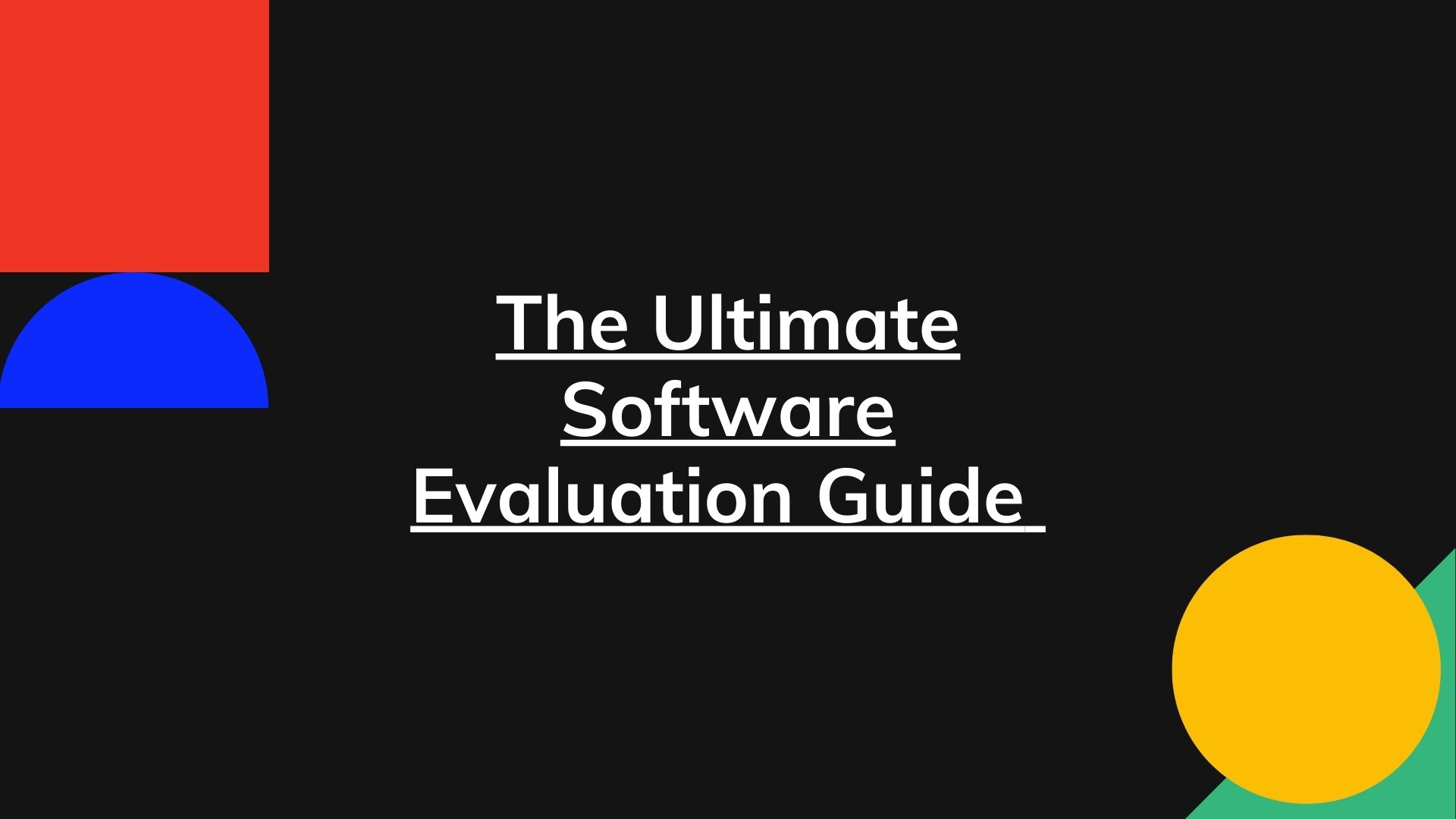Software can streamline processes, save time, increase revenue and improve a company’s operations. However, not every software solution will be a good fit for your organization. Software evaluation can help you determine whether a solution is worth the investment.
But where do you begin? How does evaluation work and why is it so important? This software evaluation guide will cover the most important aspects of the evaluation process and how to carry it out.
What is Software Evaluation?
Software evaluation is the process of assessing software or a combination of software programs to determine whether it’s a good fit for an organization. By creating a list of criteria and experimenting with the software, it’s possible to determine whether the program in question will be helpful or whether a different program or combination of programs will better serve the organization’s needs.
Software evaluation is not a quick process. In many cases, it takes considerable time to talk to vendors and assess each option.
Why Does a Company Need to Evaluate Software?
Although time-consuming and tedious, software evaluation is important. With so many tech options out there, it’s tempting to jump from one solution to another each time there’s a new release. However, blindly adopting new software or a suite of software programs can have negative consequences.
Software evaluation:
- Helps companies avoid spending on software that doesn’t meet their needs or solve problems.
- Saves time on training and adoption of software that winds up being inadequate.
- Ensures that everyone is on board with the adoption of the software or suite of software programs.
Without a proper evaluation, companies can easily waste a great deal of time and money on software that doesn’t meet their needs. Rather than bouncing from one solution to the next, companies can invest in a solution that they know will meet their needs and goals.
Who Should Be Involved in A Software Evaluation
The software evaluation process is a complex and collaborative process that will involve several people, including:
- Stakeholders, including the person responsible for leading the evaluation and the decision-maker. These individuals will play an important role in keeping the evaluation on track.
- The people who will be using the product. These individuals can provide input on whether the software is feasible for day-to-day use. Software that is complicated or difficult to use will make adoption more challenging.
- The IT/security team. These individuals can assess the technical impact of the software.
- Legal. These individuals can determine whether the software may impose any legal or compliance issues.
Those who are involved in the evaluation process will need to work together to determine whether the software is feasible or practical. The size of the evaluation team will depend largely on the size of the organization and the type of software being evaluated.
The team should be primarily focused on the evaluation process. Once a team is in place, the evaluation can begin.
What Criteria Should Be Included in a Software Evaluation?
It’s important to have a list of criteria to use during the evaluation process. There are several things that need to be considered to determine whether the software or software programs will be a good fit for the company.
Functionality
One of the first and most important things to evaluate is the software’s functionality. Several things need to be considered when evaluating functionality.
- Consider the organization’s pain points and challenges that may be solved by software. Determine whether any of the software’s functionalities can solve these issues.
- Consider repetitive, routine tasks that can be automated with software. Can the software provide the level of business process automation that’s required?
Ultimately, the goal is to determine whether the software’s features and functions can solve a real problem, such as saving time or reducing errors.
Evaluating the software’s functionality will likely be a lengthy process, but it’s one of the most important steps.
UI and UX
The software’s user interface (UI) and user experience (UX) must be assessed. Consider how tech-savvy the users are, and whether the software will be easily adopted by users.
Consider whether the software is:
- Easy to learn
- Pleasant to use
- Efficient
If the software is complicated and cumbersome to use, it will be difficult to get users to adopt and use it. Input from end-users will be invaluable for this part of the evaluation process.
Business Case
New software should only be purchased if it solves a real problem. For this reason, business case should be a part of your evaluation criteria.
The software you’re considering should do at least one of the following:
- Save time
- Improve collaboration and productivity
- Increase sales and revenue
- Improve and streamline decision-making
If the software can’t help with any of the above or won’t truly have a positive impact on the business, then it may not be a worthwhile investment.
Integrations
Consider all integrations and possible use cases for the software.
- Can you integrate the software with other tools in your tech stack?
- How does the software fit into your current stack?
- What other tasks or problems can the software solve?
If the software can only solve a single problem, then it may not be worth the investment.
Pricing
Of course, pricing will be a part of the evaluation criteria, and it will be an important one. Does the software fit into your budget? Does it provide a return on your investment (time savings, increased revenue, etc.)?
Need pricing? Here’s software pricing that’s hard to find for these products
- Asana
- DocuSign
- Airtable
- Salesloft
- Outreach
- Slack
- ClickUp
- Lucidchart
- Lusha
- ActiveCampaign
- HelloSign
- Loom
- Gong
- Keap
- Calendly
While pricing should not necessarily be the deciding factor, it will be a major factor in determining whether the software will be viable.
Software Evaluation Must-Haves
When you evaluate software, there is a lot to consider. However, some items are non-essential, and others are simply must-have items. You’ll want to add your own must-have items to this list, but it’s a good starting point for software evaluation:
Pricing
Cost is a major consideration because you need to receive approval for the software that you want to incorporate into your tech stack. You don’t want to waste time and resources on evaluating software that won’t fit into the budget.
Instead, you should:
- Discuss the true budget for the software you need
- Confirm with accounting and shareholders what can be spent monthly and annually on the solution
Often, software licenses or even software-as-a-service (SaaS) have a monthly and annual price. Annual costs are discounted to incentivize paying upfront.
You’ll want to discuss your options with the vendor to learn:
- Base pricing of software
- Users/seat limits
- Cost for additional users/seats
- Cost for each tier of service
If you believe that your team may exceed limits offered under a pricing tier, discuss the cost of with the vendor and learn what custom price they can provide.
Security
Security is a major concern, especially when you learn that a single data breach can cost $120,000 at a minimum for a small business to rectify. One of the major “features” to examine is security.
You’ll want to ask the vendor about:
- Backup solutions in place
- Redundancy to keep software up and running
- Encryption
- Security measures taken if using SaaS solutions
If you evaluate software that is being used on your own internal network, it’s up to your IT team to strengthen security. However, if using SaaS solutions, you’ll want to question the vendor on what security measures they have in place to secure your data.
Workflow and Integration
Are you putting any thought into the workflow and integration of the new software? Every new solution requires training, integration and will have a learning curve. You’ll want to evaluate software integration, such as the software’s integration options.
For example, you may need to find cash flow software for your business that integrates with your accounting software.
In this case, you’ll want to ensure that the software you’re evaluating will integrate with the solutions you use or the workflow already in place. Immediately remove any solutions that are not a good fit because integration will be timely, costly or require you to switch multiple solutions to make it work.
Legal Requirements
Depending on the industry, the solution may need to meet certain legal requirements. For example, in the medical field, strict legal requirements are in place to ensure that patient data is never exposed or accessible to non-authorized parties.
Your industry may require a certain level of encryption or redundancy in place to meet legal requirements.
Evaluate software based on these legal requirements to reduce your choices quickly. If the software doesn’t meet the legal requirements, you can move on to the next solution on your list.
Solve Key Problems
Finally, the last item on our must-have list is that the software must solve the key problem you’re trying to fix. A few of the things to consider are:
- Does the software solve your problems?
- What additional aspects can the software help?
- Does existing solutions also solve your problems?
Oftentimes, it’s important to reach out to your current software vendors to learn whether there’s a way to solve your problems without integrating a new solution into your workflow. You may find that the vendor has a different tier or version of their software that can fill your needs.
Why is this an important step in software evaluation?
It will take time, money and resources to find new software, evaluate solutions and then train staff on how to use the new solution you have in place. If you can use the same software that your team knows how to use already, it is better than going to a new solution that has a long learning curve.
9 Software Evaluation Tips
Over time, you’ll master software evaluation. However, there are a lot of tips to help make the process easier. A few tips that can streamline the process and make it easier include:
- What problem are you solving? You must make a business case for the solution you choose. Ideally, the solution will solve your problem. The first question on your evaluation list should start with: does the software fit the business case? You’ll narrow down your list of options rapidly by starting with this question.
- Consider at least three software solutions. You should look at multiple software options to find the one that fits your needs best. If you only go to the industry leader for a solution, you may be missing out on solutions that are more innovative.
- Compare to the status quo. Always look for solutions that are on par or exceed the status quo.
- Support. What level of support is available? You may need training and to have the business train your employees, if possible. Some providers may have training that will help you rapidly leverage the solution in your business.
- Consider implementation. Implementation of any software will come with some level of cost. Discuss implementation time and costs with the IT team and potential productivity lost during the initial learning period for employees.
- Involve multiple departments. You may be responsible for evaluating the software, but you should bring in multiple departments when possible. For example, if you’re testing in eCommerce solutions, you may need to talk to IT, developers, marketing team leads and so on. These individuals will help you ensure the software fits well into their business needs.
- Demo products when possible. If software providers offer a demo period, be sure to use it to try the solution.
- What onboarding is available? You should ask vendors what their onboarding looks like. Perhaps the onboarding is on a user-by-user basis, so everyone in your team will receive basic training that will make integration easier.
- Test for quality assurance. You should test out the software thoroughly, going through the solution step-by-step to learn how it works and fits with what you have in place.
Formalizing the processes that you use to evaluate software is one of the best things you can do to help your team today and in the future.
Formalize Your Software Evaluation Process
Formalizing software evaluation has been the focus of many studies, and it should consider three main things:
- Processes
- Technology
- Human resources
First, what are your processes in place and where can they be improved? Creating checklists, protocols and procedures to outline these processes is a must. You’ll want to put common questions down, such as:
- What problem are you trying to solve?
- What is our current process breakdown?
- Do any of our existing software have solutions to fill your needs?
Fill in these questions to help you and future employees evaluate software. Next, examine the current technology in place. Protocols must be put in place to determine if the new solutions will fit into existing workflow, how to work with IT to ensure your tech stack can handle the solution and also how the software will be evaluated.
Software evaluation will require you to go through a series of steps when finding, comparing and testing solutions.
Document all of these steps so that if you’re not around in the future, someone else can replicate your process with precision.
Finally, you’ll also want to consider what human resources are needed for:
- Testing software
- Integrating software
- Training staff
You want to put steps in place that will allow IT to work with evaluators to discuss integration, training methods and even how to test each solution. The more details that you can include, the better.
How To Successfully Evaluate Software
Software evaluation should never be a one-person process. If you’re not evaluating software properly, it can lead to significant resource loss and expenditures. You should do a few things to ensure the evaluation is done properly:
- Work with the proper stakeholders. For example, if the accounting team is the one that is going to use the software, be sure to include them in the evaluation process. Team leaders or managers are the ideal stakeholders to discuss work with. You’ll also want input from owners, contributors and decision-makers.
- Collaborate with stakeholders to ensure that the solution is a good internal fit and one that will work well for your business.
- Provide feedback to the vendor to learn if the solution does offer a feature or other option that is a sticking point for the company.
- Ask for recommendations from others in the industry or from internal team members. There are often a lot of employees or stakeholders who keep on top of software in the industry, and they can offer recommendations on what may work best for your business case.
- Expert advice is also available, and you may need to pay for it. Consultants already have a pulse on the software available and can be invaluable in the decision-making process.
There’s a lot that goes into software evaluation, and while the points above are just some of the things you should be doing, creating a checklist to evaluate software is also a good idea.
Make a Software Evaluation Checklist
Creating an internal software evaluation checklist can help you speed up future evaluations and reduce the risk of errors. The list below is a good starting point for creating your own internal checklist:
| Item | Complete |
| Does the software support the objectives and needs of the business? | |
| Is the solution well documented? | |
| Does the software meet standards and goals? | |
| Will the software fill a need that an existing solution doesn’t? | |
| Does the software fit into your budget? | |
| Do you need to integrate new hardware to run the solution? | |
| Has IT been in the loop? | |
| Have you collaborated with all stakeholders on choosing the software? | |
| Is training provided? | |
| Is support available for integration? | |
| Do you have to pay for support? | |
| Will the existing workflow need to change? | |
| Does the software meet legal requirements? | |
| Can the solution scale with business growth? | |
| Has the software been thoroughly tested by an internal team? | |
| Does the solution have a demo to try? | |
| Have all stakeholders approved the software and its use in the business? |
You can also create a checklist that will go through the exact internal process used when testing the solution.
Software evaluation is an art, and over time, you’ll master the process of evaluating software. First, start with understanding your business case and the problem you need to solve. Next, start bringing in stakeholders to learn about budgets, decision-makers, existing solutions and more.



